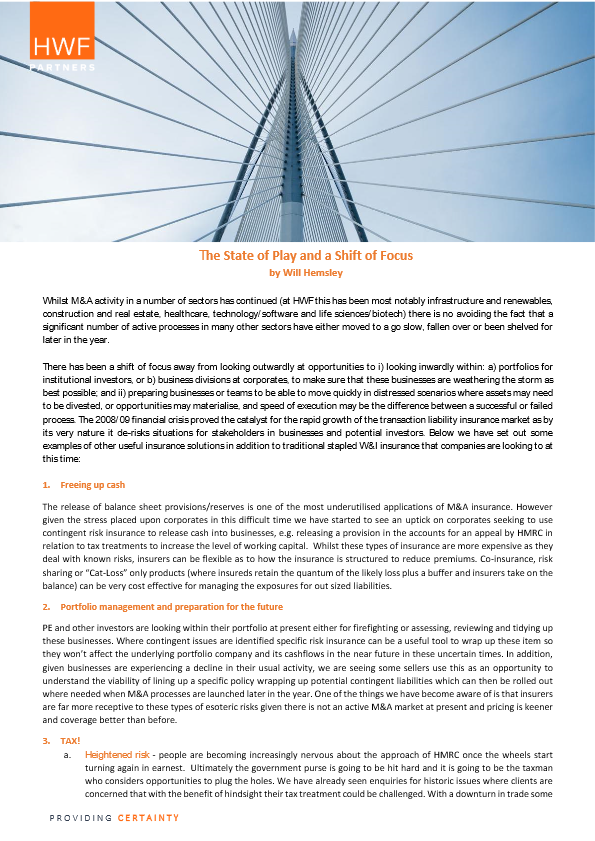There has been a shift of focus away from looking outwardly at opportunities to i) looking inwardly within: a) portfolios for institutional investors, or b) business divisions at corporates, to make sure that these businesses are weathering the storm as best possible; and ii) preparing businesses or teams to be able to move quickly in distressed scenarios where assets may need to be divested, or opportunities may materialise, and speed of execution may be the difference between a successful or failed process. The 2008/09 financial crisis proved the catalyst for the rapid growth of the transaction liability insurance market as by its very nature it de-risks situations for stakeholders in businesses and potential investors. Below we have set out some examples of other useful insurance solutions in addition to traditional stapled W&I insurance that companies are looking to at this time:
1. Freeing up cash
The release of balance sheet provisions/reserves is one of the most underutilised applications of M&A insurance. However given the stress placed upon corporates in this difficult time we have started to see an uptick on corporates seeking to use contingent risk insurance to release cash into businesses, e.g. releasing a provision in the accounts for an appeal by HMRC in relation to tax treatments to increase the level of working capital. Whilst these types of insurance are more expensive as they deal with known risks, insurers can be flexible as to how the insurance is structured to reduce premiums. Co-insurance, risk sharing or “Cat-Loss” only products (where insureds retain the quantum of the likely loss plus a buffer and insurers take on the balance) can be very cost effective for managing the exposures for out sized liabilities.
2. Portfolio management and preparation for the future
PE and other investors are looking within their portfolio at present either for firefighting or assessing, reviewing and tidying up these businesses. Where contingent issues are identified specific risk insurance can be a useful tool to wrap up these item so they won’t affect the underlying portfolio company and its cashflows in the near future in these uncertain times. In addition, given businesses are experiencing a decline in their usual activity, we are seeing some sellers use this as an opportunity to understand the viability of lining up a specific policy wrapping up potential contingent liabilities which can then be rolled out where needed when M&A processes are launched later in the year. One of the things we have become aware of is that insurers are far more receptive to these types of esoteric risks given there is not an active M&A market at present and pricing is keener and coverage better than before.
3. TAX!
a. Heightened risk – people are becoming increasingly nervous about the approach of HMRC once the wheels start turning again in earnest. Ultimately the government purse is going to be hit hard and it is going to be the taxman who considers opportunities to plug the holes. We have already seen enquiries for historic issues where clients are concerned that with the benefit of hindsight their tax treatment could be challenged. With a downturn in trade some clients are concerned as to whether they will have the cash to meet any additional tax demand. Insurers will cover any advanced costs so even where clients believe their positions are on the balance of probability fine, insurance will be used as it has the advantage of stumping up the cash should there be an advanced payment required to defend a challenge.
b. Restructuring of current portfolio holdings – as portfolios see a downturn in trading activity and revenue, there may be considered a need to restructure existing financing arrangements. There are certain tax risks involved with writing off / release of debt, undertaking debt-for-equity swaps etc that can potentially lead to material tax charges arising. Provided that sensible advice has been taken, specific tax insurance can remove this risk, together with any interest, penalties and costs incurred in defending a tax authority challenge.
4. What is next – Distressed de-stressed
Whilst we all hope and expect the downturn not to be as damaging as the last financial crisis, there will unfortunately be some distressed businesses and turmoil in the markets for some time to come. As one of the only brokers who are able to draw on a team with experience from the last economic crash we expect to see the traditional W&I insurance, tax liability insurance, environmental insurance and contingent risk insurance all play a part in some of the restructurings, carve outs, fire sales, pre packs, debt for equity swaps and other distressed situations to follow. In addition, given the specialist M&A insurance market has evolved a long way since the last time these types of situations were in the market in great volumes there has been a shift away from the traditional and an increased use of some of the more revolutionary products the market has at its disposal. A prime example being wholly synthetic warranty products where there is no seller of substance or management to give the warranties, so the insurer fills the gap in giving the warranties as well as standing behind the liabilities.
As detailed in the scenarios above, whilst there will naturally be a downturn in M&A activity (although we still expect to see a handful of opportunistic acquisitions or take privates) and therefore less appetite for traditional M&A insurance, the transactional liability market offers a plethora of other remedies (particularly for existing risks) for businesses that can have a real positive financial outcome by freeing up cash for corporates and portfolio businesses.


